Hi, there are 3 study cases that I have attached through, each case they need us to read and identify the theme, issue and applying theory such as agency theory, legitimacy theory, stakeholder theory
Rio Tinto
“Rio Tinto operates under a dual listed companies (DLC) structure. This structure is designed to place the shareholders of Rio Tinto plc and Rio Tinto Limited in substantially the same position as if they held shares in a single entity owning all of the assets of both companies.
Under the DLC structure, the businesses of Rio Tinto plc and Rio Tinto Limited are managed together, the boards of directors of each Company are the same, and shareholders of each Company have a common economic interest in the DLC structure.” https://www.riotinto.com/en/invest/shareholder-information/dual-listed-companies-structure
“As pioneers in mining and metals, we produce materials essential to human progress. Iron ore for steel. Aluminum for cars and smartphones. Copper for wind turbines, electric cars and the pipes that bring water to our home. Borates that help crops grow, titanium for paint – and diamonds that celebrate the best things in life.We work in 36 countries – in mines, smelters and refineries, as well as in sales offices, data centres, research and development labs and with artificial intelligence. Our geologists explore the Earth’s wildest terrain. Our wildlife specialists work to protect and conserve grizzly bears in Canada and migratory shorebirds in Western Australia. Our marketing teams make sure our essential materials meet the specific needs of customers around the world.
We are home to one of the world’s largest robots and maybe one of the smallest – we call him Mark. We built a wind farm 200 kilometres south of the Arctic Circle to help power our diamond mine, and in 2018 became the only major mining company to stop producing fossil fuels, including coal. We want to be part of the solution to climate change, and believe we are.
We aim to deliver superior returns to our shareholders throughout the cycle by meeting our customers’ needs, allocating capital with discipline, and investing in high-quality projects and in industries with solid, long-term fundamentals.
We were founded in 1873, on the banks of the Rio Tinto river in Andalusia, Spain. We are proud of everything we have achieved. At Rio Tinto, we know our future is even brighter than our past.” https://www.riotinto.com/about
Juukan Gorge 2020: the story through the media
Is a 46,000-Year-Old Site Less Sacred Than Profits?
David Fickling June 13 2020, 5:30 AM June 16 2020, 9:07 AM (Bloomberg Opinion) –https://www.bloombergquint.com/business/rio-tinto-s-demolition-of-sacred-site-doesn-t-match-its-image Copyright © BloombergQuint
It seemed like an incident from another era. Rio Tinto Group last month demolished a 46,000-year-old site sacred to the Puutu Kunti Kurrama and Pinikura peoples to make way for an expansion of its Brockman 4 mine in Australia’s iron-rich northwestern Pilbara region. The act has been likened to the destruction of Palmyra by the Islamic State. It wasn’t only the Juukan Gorge caves that were blasted, though. Such a blithe act, and management’s subsequent inability to explain it, has undermined the decades Rio Tinto spent presenting itself as the socially responsible face of the mining industry. How could such an event happen? If you see mining companies the way they like to present themselves — as benevolent middle men, aiding the economic development of formerly colonized peoples while providing materials for the industrial development of the planet — then it’s inexplicable that they could display such indifference at a site nearly three times as old as the Lascaux Caves. That’s mostly a story for the cover of the corporate responsibility report. While mining companies employ plenty of people sincerely committed to land rights and no doubt believe much of their own rhetoric, a middle man isn't working for the sake of his suppliers or customers —he’s trying to maximize his own returns.
When you’re dividing up the pie from selling mineral products, any cash spent giving landowners just compensation is money that’s not going to shareholders. Rio Tinto has spent decades burnishing a reputation for treating landowners better than some of its peers — but it’s a lot easier to be the good guy when the deck is so heavily stacked in your favor. As in many parts of the former British Empire, ownership of land in Australia was transferred to the Crown by a legal fiction upon European invasion in 1788. Until the middle of the 20th century, Aboriginal people in remote areas often worked as ranchers or servants in return for tobacco, sugar, tea and clothing — conditions not many rungs above slavery. The current disparate Indigenous Australian land-rights regimes were established from the 1970s to the 1990s against that backdrop. Despite the triumphs of figures such as Vincent Lingiari and Eddie Mabo in using strikes, political appeals and legal cases to win formal rights over land, campaigners have always had to fight off the back foot. The result isn’t hard to see on a visit to an outback Aboriginal community. Despite the fact that such areas host some of the world’s most lucrative mines, Indigenous Australians die about 14 years younger than their non-indigenous neighbors in remote areas. In the most isolated regions, they’re paid just 28 cents for every dollar earned by others and four out of 10 households are overcrowded.
I’m from the U.K., where landowners still form an aristocracy that includes many of the country’s richest people. It’s depressing that as a migrant to Australia, I’m better off than most of the traditional owners on whom this country’s wealth was built. This manifest injustice is explained in a variety of ways. Legally, land rights for Indigenous Australians are considered to have been “extinguished” if they were driven off their land in the past to make way for ranching, mining, real estate or infrastructure. That formula, one of the cornerstones of the country’s so-called native title system, bestows a blessing on a historical act of theft, rather than seeking to redress it.
Politically, the miserable conditions that prevail in many remote Aboriginal communities are blamed on social breakdown and the perception (often justified) that money spent on Indigenous advancement has been wasted on corruption and mismanagement — in essence, blaming Indigenous people for their own dispossession and exploitation. For all that such problems are attributed to a surfeit of “welfare,” though, Australia spends just A$3.3 billion ($2.26 billion) a year on Indigenous-specific government programs, with much of that budget dedicated to closing inequalities in education and health. That’s far less than the A$14 billion or so a year that state and territory governments get from mining royalty payments.
A first step toward reversing this would acknowledge the immense damage that mining and industry can do to landscapes that are an essential part of the world’s cultural legacy. Aboriginal people were the first to colonize a new continent by sea, and were grinding seeds for flour and stone to make axe-heads 20,000 years before the same technologies helped kick-start the agricultural revolution in ears before the same technologies helped kick-start the agricultural revolution in the Fertile Crescent. At Murujuga near the Pilbara iron ore port of Karratha, a nominated world heritage site hosts more than a million petroglyphs — including depictions of extinct megafauna and the oldest carved images of human faces — hard against an LNG terminal, explosives factory and fertilizer plant.
The destruction of the Juukan Gorge caves wasn’t an isolated incident. The Pilbara is thick with such cultural artifacts. A few days later, BHP Group received approval from Western Australia’s government to demolish 40 sites. Fortescue Metals Group Ltd. is seeking similar permission to expand its Solomon mine, where excavated sites include a cave whose occupation dates back 60,000 years.
The solution isn’t to stop mining. In communities that have suffered neglect by the state, these companies are often welcomed as the only partners in economic development — but the current regime is clearly not working for traditional owners. What resources companies have always sought is a “social license to operate.” For too long, though, those notional licenses have been handed out in return for relatively paltry royalty payments, often in the form of in-kind agreements to employ local workers and provide health, education and infrastructure that the state fails to fund properly.
What's needed is legal and political change. Australia’s native title laws skew the playing field in favor of resources companies, and must be reformed to give local communities rights to a larger share of the billions of dollars their land produces. The deal that South Australia state recently handed out to mostly white farmers with little fanfare— a cash royalty on new gas production equivalent to about 1% of the sale price — is the sort of settlement that many Aboriginal groups have fought and failed to win through decades of court battles. There are signs that change may be afoot. Australia’s High Court last month denied an appeal by Fortescue against a 2017 judgment, ensuring the Yindjibarndi people would hold a form of native title close to freehold land ownership. That precedent should strengthen the hand of Indigenous groups in negotiating with mining companies in the future. A separate judgement last year also gave more guidance for how the value of native titles should be assessed, and found it to be substantially above the sort of sums that have typically gone to title-holders. If similar payments were assessed for even just 5% of native title land, traditional owners would be entitled to some A$280 billion, according to one analysis of the case by law firm MinterEllison. In the Australian context, such enormous numbers are generally regarded as evidence that Indigenous land claims are politically impractical. In fact, they’re a small demonstration of the scale of what has been stolen. It’s well past time for those right to be restored. In some cases such "stolen wages" practices went on until the 1970s. After the 1950s notional cash salaries were normally paid, though often they were credited to trust accounts that Indigenous workers couldn't easily access, and that governments often plundered for unrelated spending.
The term "traditional owners" is used in Australia to encompass Indigenous people with freehold ownership of their land, as in parts of the Northern Territory; those who have more limited rights after winning native title cases; and those who haven't won any formal legal recognition of their land rights, as in most urban areas. This column does not necessarily reflect the opinion of the editorial
Rio Tinto blasted ancient Aboriginal caves for $135m of iron ore
By Nick Toscano and Hamish Hastie Sydney Morning HeraldAugust 7, 2020 — 11.38am
https://www.smh.com.au/business/companies/rio-tinto-blasted-ancient-aboriginal-caves-for-135m-of-iron-ore-20200807-p55jia.html
Mining giant Rio Tinto decided to destroy two 46,000-year-old Aboriginal rock shelters in order to access $135 million worth of iron ore that would not have been available under alternative mining plans avoiding the culturally significant site. The nation's second-largest miner has faced a storm of condemnation after legally destroying the ancient site in Western Australia's Juukan Gorge, against the will of the land's traditional owners, on the Sunday before National Reconciliation Week.
Fronting a federal parliamentary inquiry into the events on Friday, Rio Tinto CEO Jean-Sebastien Jacques outlined how the miner had considered four options to expand its Brockman 4 iron ore mine in 2012-13, three of which would have avoided the Juukan shelters by varying distances. But the company opted for a fourth option, Mr Jacques said, which involved destroying the site in order to access a greater amount of higher-grade iron ore. "The difference was 8 million tonnes of higher-grade iron ore," Mr Jacques said. The value of that volume of the steelmaking raw material at the time was estimated to be $135 million, he added. In 2019 Rio Tinto shipped 327.4 million tonnes of iron ore from the Pilbara.
Under questioning, Mr Jacques said the land's traditional owners – the Puutu Kunti Kurrama and Pinikura (PKKP) people – were never told there were other options that could have protected the Juukan Gorge site. "The PKKP was not made aware that four options were available in 2012 and 2013," he said. "Only one option was presented to the PKKP."
Warren Entsch, chair of the Joint Standing Committee on Northern Australia, said he was disturbed by the fact the PKKP were not fully informed about other possible mining plans, and wanted the inquiry to delve further into the matter at a later date.
Report reveals Rio Tinto knew the significance of 46,000-year-old rock caves six years before it blasted them
RN Breakfast ABC News
https://www.abc.net.au/news/2020-06-05/rio-tinto-knew-6-years-ago-about-46000yo-rock-caves-it-blasted/12319334
By Gregg Borschmann
Posted: Friday 5 June 2020 at 7:08am, updated Friday 5 June 2020 at 2:52pm

Evidence of more than 40,000 years of human habitation was discovered during the excavation of one of the Juukan rock cave sites in 2014.(Supplied)
Mining giant Rio Tinto was alerted six years ago that at least one of the caves it blasted in Western Australia's Pilbara region last month was of "the highest archaeological significance in Australia".
Key points:
Reports on the site describe one of the caves as the "only one in the Pilbara to contain such aspects of material culture"
Rio Tinto was advised of the heritage significance before the $15 billion expansion of its Pilbara mines
Traditional owners opposed the destruction of the caves in a 2015 documentary funded by Rio Tinto.
The cave sites were among the oldest in Australia, with evidence of continuous human habitation going back 46,000 years. Advice delivered to Rio Tinto and the Puutu Kunti Kurrama and Pinikura (PKKP) Indigenous people of the region six years ago was never publicly released.
The ABC has been given a summary of the contents of the report, as well as earlier archaeological survey work and excavations at the sites dating back to 2004.
The documentation of the 2014 report by archaeologist Dr Michael Slack confirmed one of the sites that was blasted, the Juukan-2 (Brock-21) cave, was rare in Australia and unique in the Pilbara. "The site was found to contain a cultural sequence spanning over 40,000 years, with a high frequency of flaked stone artefacts, rare abundance of faunal remains, unique stone tools, preserved human hair and with sediment containing a pollen record charting thousands of years of environmental changes," Dr Slack wrote. "In many of these respects, the site is the only one in the Pilbara to contain such aspects of material culture and provide a likely strong connection through DNA analysis to the contemporary traditional owners of such old Pleistocene antiquity."
Michael Slack said he believed there was more excavation work to be done on Juukan Gorge before the area was blasted by Rio Tinto.
Dr Slack and his team removed 7,000 artefacts from the caves in 2014 and the executive summary states: "The results of the excavations at Brock-21/Juukan-2 are of the highest archaeological significance in Australia."
Rio Tinto funded documentary celebrating the caves
Rio Tinto seemed to be aware of the unique value of the site the year after they received the archaeological report and in 2015, the mining company funded a documentary called Ngurra Minarli, which means In Our Country.
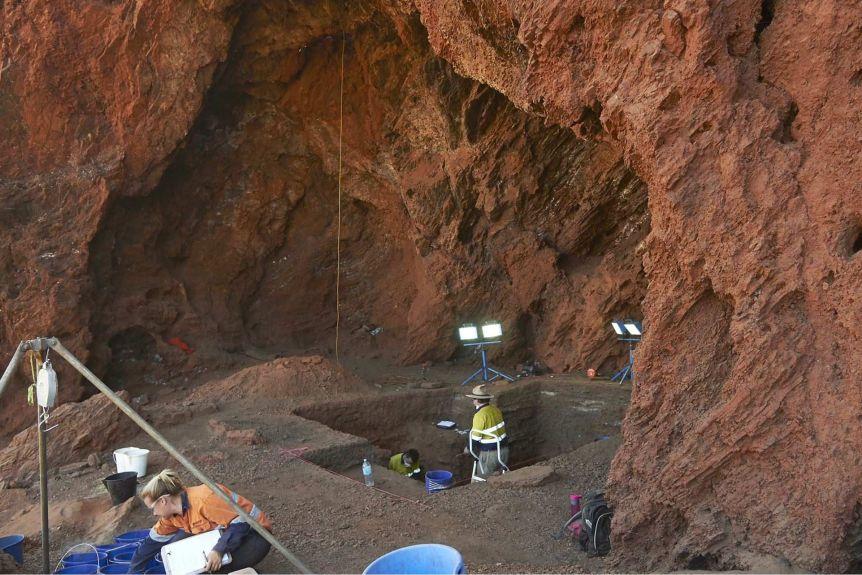
7,000 artefacts were discovered during the excavation of the Juukan-2 site.(Supplied)
The documentary featured PKKP traditional owners expressing concern about protecting the remaining cultural sites in the area, including the Juukan rock caves. Traditional owner Harold Ashburton said he had recently taken his two sons to the area. "I showed them Brockman, where my grandfather was born, first time they'd been out in a grandfather's country," he said in the documentary. "They turned and said, 'It’s f***ed because of mining. What [have] they done to the country?”
In an interview with RN Breakfast, Chris Salisbury, chief executive of Rio Tinto iron ore described the destruction of the caves as a "misunderstanding". He said the company was sorry for the "distress and anguish" of the PKKP people and took "full accountability". "Something's gone terribly wrong here and we've committed to a comprehensive review of all of our heritage process and moreover committed to advocating for legislative change to prevent this sort of thing happening, should it be necessary," Mr Salisbury said. "We can't move back, we can't keep looking backwards, we want to repair our relationship with traditional owners."
Rock shelters were already doomed
Rio Tinto's Brockman 4 mine was expanding and operating less than one kilometre away from the Juukan rock cave sites when Dr Slack's team conducted its 2014 excavation of the site. The dig excavated down 1.8 metres to bedrock across a 15-square-metre section in the centre of Juukan 2.
It revealed compelling new evidence for the rarity and importance of both Juukan 1 and Juukan 2.
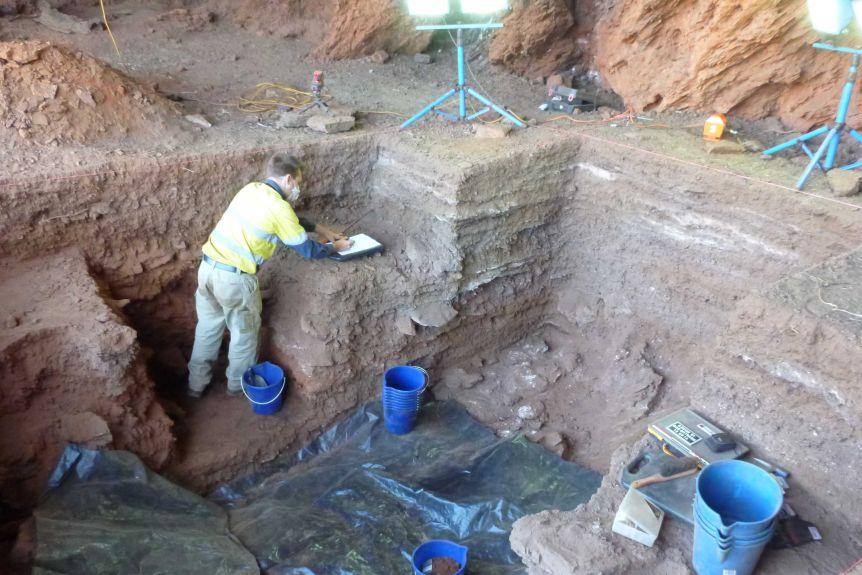
The Juukan caves were excavated in 2014 and determined to be of the "highest archaeological significance".(Supplied)
However, because the dig was described by Dr Slack as "extensive salvage excavations" it appeared that by 2014, both caves were already doomed. Only months before the dig started, Rio Tinto secured a Section 18 consent under the WA Aboriginal Heritage Act in December 2013. The permit meant the company could not be prosecuted for "excavating, destroying, damaging, concealing or in any way altering any Aboriginal site". This consent was issued by the WA Registrar of Aboriginal Sites despite an earlier report in December 2008 by Dr Slack, pointing to "high archaeological significance" of at least three sites in the region, which included the two Juukan caves.
The first archaeological assessment of the caves, recommending further research and possible listing and protection under WA heritage law, was done in 2004. Among other sites, it recommended the caves "should be avoided" by the company and its employees because they contained "a significant amount of cultural material".
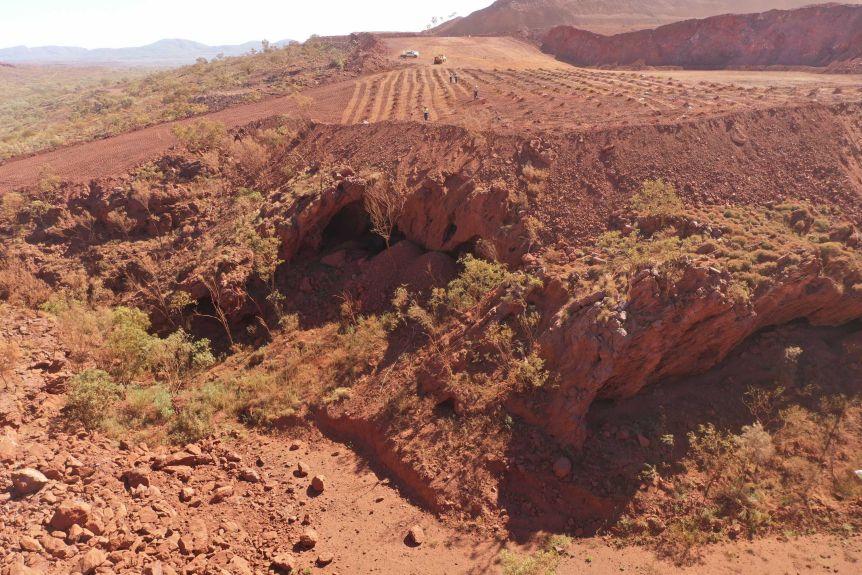
Rio Tinto was given permission to blast Juukan Gorge 1 and 2 under Section 18 of the Aboriginal Heritage Act.(Supplied: Puutu Kunti Kurrama And Pinikura Aboriginal Corporation). For his 2008 report, Dr Slack did test excavations of 12 rock shelters and additional recording and mapping at 20 open-artefact scatters around Mount Brockman and the upper watersheds of Boolgeeda Creek, Duck Creek and the Beasley River.
"Of the sites recorded, most (30) are considered to be of low archaeological significance 30, nine are considered to be of medium significance, and three are assessed as being of high archaeological significance," Dr Slack reported. Twelve years before they were detonated, Dr Slack had already singled out the Juukan caves as being especially important. "BROCK-21 [Juukan 2] is assessed as being of high archaeological significance," he wrote. "Our excavations have indicated that the deposit is of great antiquity and has the potential to be even older.” "Although we have only presented some initial analysis in this report, there is much more refinement that is needed to be done to the analysis of both stone and bone."
But the report stated that even "at this early stage of analysis, we can definitively show that the BROCK-21 site qualifies" for listing as a protected site under the Aboriginal Heritage Act "on the basis of both research potential and representativeness as being of high archaeological significance".

An expansion of operations by Rio Tinto in 2010 included the Brockman 4 mine near the two rock caves.(Babs McHugh: ABC Rural)
Largely as a result of this report, by 2013, the Juukan caves had been placed on the list of protected areas under the act — the same year Rio received permission to destroy them. Dr Slack's work in 2008 was a prelude to a $15 billion expansion of Rio Tinto's operations in the Pilbara from 2010, extending existing mines and building new ones to increase iron ore production by 50 per cent.
The Brockman 4 mine — fatally for the Juukan caves — was one of those expanding operations.
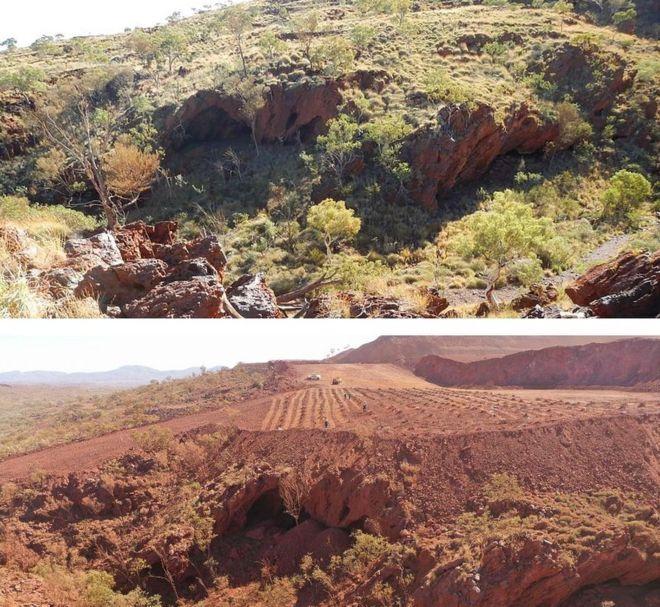
Image copyrightAFPImage captionJuukan
Mining giant Rio Tinto has cut the bonuses of three executives over the destruction of two ancient caves in Australia.
BBC News 24 August 2020 https://www.bbc.com/news/business-53885695
In May, the world's biggest iron ore miner destroyed the sacred Aboriginal sites in Pilbara, Western Australia.
The company went ahead with the destruction of the Juukan Gorge rock shelters despite the opposition of Aboriginal traditional owners. They were among the oldest historic sites in Australia. The caves showed evidence of continuous human habitation dating back 46,000 years.
Rio Tinto's chief executive Jean-Sebastien Jacques will lose a total of £2.7m. Chris Salisbury, chief executive of iron ore, and Simone Niven, group executive of corporate relations, will lose payouts of more than half a million pounds each.
The company, whose shares are listed in both London and Sydney, said it would provide more details on the bonus cuts in its 2020 remuneration report. All three will remain in their roles. "It is clear that no single individual or error was responsible for the destruction of the Juukan rock shelters," said Rio Tinto chairman Simon Thompson. "But there were numerous missed opportunities over almost a decade and the company failed to uphold one of Rio Tinto's core values - respect for local communities and for their heritage." The sites were above about eight million tonnes of high-grade iron ore, with an estimated value at the time of £75m.
"We will implement important new measures and governance to ensure we do not repeat what happened at Juukan Gorge and we will continue our work to rebuild trust with the Puutu Kunti Kurrama and Pinikura people," said Mr Thompson.
The review found that while the company had obtained legal authority for the blasts, the decision fell short of the standards and internal guidance Rio Tinto had set for itself. It also found that the firm had failed to properly engage with the Puutu Kunti Kurrama people, the traditional owners of the site.
'Devastating blow'
After the caves were destroyed, a PKKP representative, John Ashburton, said losing the site was a "devastating blow".
There are less than a handful of known Aboriginal sites in Australia that are as old as this one... its importance cannot be underestimated," he said, according to the news agency Reuters. "Our people are deeply troubled and saddened by the destruction of these rock shelters and are grieving the loss of connection to our ancestors as well as our land."
Media caption Miriwoong: The push to keep the Australian language alive
Mr Salisbury apologised for the company's actions at the time: "We are sorry for the distress we have caused." "We pay our respects to the Puutu Kunti Kurrama and Pinikura People," he added. The PKKP Aboriginal Corporation declined to comment.
Rio Tinto CEO, top executives resign amid cave blast crisis By Nick Toscano and Hamish Hastie Sydney Morning Herald
https://www.smh.com.au/business/companies/rio-tinto-ceo-top-executives-resign-amid-cave-blast-crisis-20200910-p55uf8.html
Updated September 11, 2020 — 4.30pm first published at 9.46am
Rio Tinto boss Jean-Sebastien Jacques and two senior executives will be replaced after an investor revolt forced the mining giant's board to escalate its response to the blasting of the ancient Juukan Gorge rock shelters.
Mr Jacques, Rio's iron ore division boss Chris Salisbury and corporate affairs boss Simone Niven will depart the company within six months, the board said, following a series of crisis meetings held this week.
Rio Tinto chief executive Jean-Sebastien Jacques will leave the company by the end of March. In a statement issued on Friday morning, the board said Mr Jacques, 48, would stay as chief executive until the appointment of his successor or until March 31, whichever was earlier.
The decision comes after months of escalating pressure from Aboriginal groups, top shareholders and government leaders over Rio Tinto's decision to destroy the two culturally significant rock shelters in Western Australia's Pilbara region, which had evidence of continual human occupation tracing back at least 46,000 years.
Mr Jacques, Mr Salisbury and Ms Niven – whose department oversees community relations – were last month stripped of $7 million of their 2020 bonuses after a board-led review found they had to bear some responsibility.
Rio chairman Simon Thompson said at the time no one would be stood down over the matter, because the board had decided they were the best people to lead the critical reforms to heritage processes that were required. What happened at Juukan was wrong. We are determined to ensure the destruction of a heritage site of such exceptional archaeological and cultural significance never occurs again at a Rio Tinto operation. Rio chairman Simon Thompson.
However, the bonus cuts failed to satisfy many shareholders and Indigenous leaders who told board members that docking the pay of well-paid executives fell significantly short of true accountability for the destruction of such a significant site.
Mr Thompson said on Friday the dramatic escalation of penalties had been prompted by a series of "important stakeholders" voicing concerns about executive accountability for the failings identified.
Peter Ker 21 August 2020 Financial Review
https://www.afr.com/companies/mining/native-americans-rio-s-copper-plan-belies-gorge-vows-20200820-p55nrm
Native American groups say Rio Tinto's plan to build a big copper mine on one of their sacred sites contradicts the company's vow to improve management of cultural heritage in the wake of this year's Juukan Gorge debacle in Western Australia.
The comments from Apache and environmental groups in the US highlight the global ramifications of Rio's decision to blast through the culturally sensitive gorge in May, and how inconvenient the timing could be for the company's plan to build a big new copper mine in Arizona.
US regulators were scheduled to file their final environmental impact study into the Resolution Copper project in July, ending eight years of approval processes and triggering a controversial land swap within 60 days.
The land swap was engineered by former Republican senator John McCain in 2014 and will allow Rio and its partner BHP access to lands that are believed to contain historical artefacts and human burial grounds. The final study has not yet been published by the US Forest Service and it is unclear whether the coronavirus pandemic or controversy over Juukan Gorge has delayed publication. The San Carlos Apache Tribe told an Australian parliamentary inquiry in the Juukan Gorge scandal that Rio was "greedily seeking" to repeat the "atrocities" of Juukan Gorge at the tribe's ''Chí’chil Biłdagoteel'' sacred site in Arizona, which is more commonly known as Oak Flat.
A second coalition of environmental and Apache groups said Rio's plans at Oak Flat belied the apologies and reform pledges made by the company in the months since Juukan Gorge was blasted.
''It is striking that Rio Tinto, after the destruction of the Juukan Gorge rock shelters, promises 'to rebuild Rio Tinto 's reputation for cultural heritage management' while in Arizona the company is moving full speed ahead with plans to completely destroy Chí’chil Biłdagoteel,'' said the Arizona Mining Reform Coalition in a submission to the parliamentary inquiry. ''We ask that the (inquiry) look carefully not only at Rio Tinto’s past track record on the destruction of sacred sites and cultural sensitivity, but at the company’s plans for the future destruction of sacred sites and culturally sensitive areas. ''What Rio Tinto is planning here in the United States ... directly contradicts the statements that Rio Tinto has made to your committee.''
The San Carlos Apache tribe have close to 17,000 members and operate two casinos within 70 kilometres of Oak Flat, which is located near the Arizona town of Superior. Rio owns 55 per cent of Resolution and is the mine's operator, with BHP owning the balance. Resolution is expected to produce 40 billion pounds of copper in concentrate over 40 years, including molybdenum byproducts, via a panel cave more than 2000 metres underground.
If the mine produced at a consistent rate over those 40 years, annual production would be about 450,000 tonnes per year; more than double the annual output from BHP's Olympic Dam mine in South Australia, but around half the annual output of the Escondida mine in Chile.
Rio spokesman said the company was determined to ensure traditional owners were consulted on development of Resolution.
“The Resolution Copper project is being evaluated and shaped through an ongoing independent process, led by the US Forest Service (USFS) under the National Environmental Protection Act (NEPA),'' he said. ''The comprehensive consultation required under NEPA ensures broad public comment and extensive government-to-government consultation with Native American tribes with historical ties to the project area.
''Resolution Copper welcomes the opportunity to continue building on the extensive engagement with Native American tribes, who play an essential role in shaping this project.”
BHP does not expect Resolution to be producing copper before 2025.
Extracts from Annual Report 2019 (https://www.riotinto.com/en/invest/reports/annual-report)
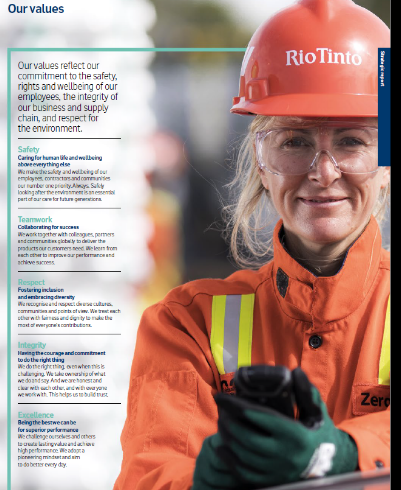
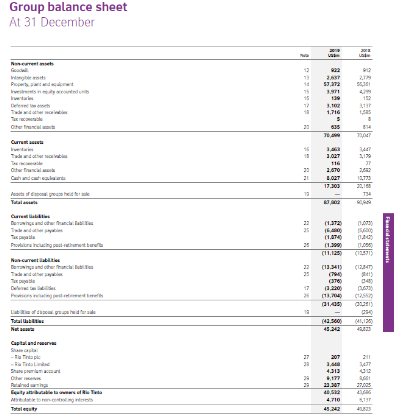
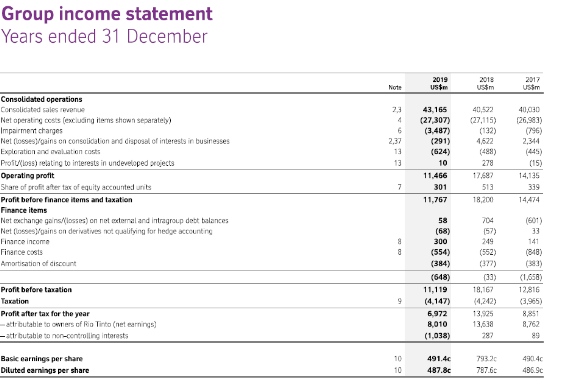
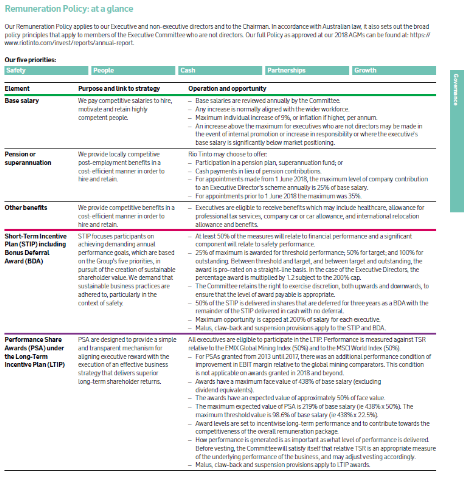
1. Producing materials essential for a low-carbon future
We supply the metals and minerals essential to human progress. Each of the commodities we produce has a role to play in the transition to a low-carbon economy.
2. Reducing the carbon footprint of our operations
Many of our operations are highly energy-intensive and some of our industrial processes also result in GHG emissions. We are taking steps to enhance productivity and efficiency, as well as exploring alternative sources of energy and developing innovative pathways to reduce emissions.
Our ambition is to reach net zero emissions by 2050. Our 2030 targets are to reduce our emissions intensity by 30% and our absolute emissions by 15% (or approximately 4.8mt CO2e).
3. Partnering to reduce the carbon footprint across our value chain
Climate change will only be solved through collective action by governments, business and consumers around the globe. We are working on innovative partnerships to stimulate action with customers and other partners across the value chain. We are also participating in industry forums and advocating policy positions to promote climate action in a responsible and sustainable way.
4. Enhancing our resilience to physical climate risks
We consider climate risks over the life of our operations, from the development of new projects through to closure and beyond. We have already experienced extreme weather events at many of our sites and are using scenarios to assess further medium- to long-term risks.
More information: https://www.riotinto.com/en/sustainability/climate-change
Environmental and climate change issues: the story through the media
Rio Tinto launches climate change report27 February 2019 https://www.riotinto.com/en/news/releases/Climate-change-report-launched
Rio Tinto today published Our approach to climate change, which shows how the company plans to contribute to and leverage the transition to a low carbon future. The report uses recommendations from the Task Force on Climate-related Financial Disclosures (TCFD) as a framework to assess the potential risks and opportunities of climate change and related policies.
Rio Tinto chief executive officer J-S Jacques said, "Given our decision to strengthen our business and exit coal, we are now the only major mining company with a fossil-fuel-free portfolio, which means we are well-positioned to contribute to a low-carbon future.
"The materials we produce, from infinitely recyclable aluminium to copper used in electrification to our higher grade iron ore product, all play a part in the transition to a low-carbon economy.
"At Rio Tinto, we have reduced our emissions-intensity footprint by almost 30 per cent since 2008, putting us on track to beat our targets. Renewable energy is now used to produce nearly three-quarters of the electricity we use.
"We are aware that we have more to consider on climate change and will work with partners such as the members of the Energy Transitions Commission, Alcoa and Apple, the World Bank and others, to look at further sustainable solutions that enable us to continue to generate profits and contribute to people, the planet and prosperity".
Rio Tinto has publicly acknowledged the reality of climate change since 2005, signed the Paris Pledge in support of the ambition and commitments set out in the Paris Agreement in 2015 and contributes to the United Nations Sustainable Development Goals.
Andrew Gray, Director ESG & Stewardship, AustralianSuper and Member, Climate Action 100+, said "Last year Rio Tinto supported the recommendations of the TCFD and we welcome their first report under this structure. 2018 saw the company undertake technological breakthroughs in materials that have a key role in the low carbon transition. We are also encouraged that Rio Tinto has joined the Energy Transitions Commission which takes a multi-sector approach to hard-to-abate sectors like steel".
James Bevan, CIO at charity specialist CCLA, said "2018 saw the completion of Rio Tinto’s strategic exit from coal. Over time the company will face other complex portfolio and operational choices, so it is useful to see initial quantification of the impact of the low carbon transition on different commodities. We look forward to reviewing Rio Tinto’s new targets and metrics for the 2020s: a critical part of the TCFD recommendations and investors’ collective Climate Action 100+ request for Paris alignment".
Climate risks and opportunities have formed part of Rio Tinto’s strategic thinking for over two decades. The company has outlined it will take action in four key areas:
1. Supply essential metals and minerals for the transition to a low-carbon economy
2. Reduce emissions from its own footprint
3. Identify and assess physical risk exposures
4. Partner to advance climate goals
Policies and technologies that reduce emissions are expected to increase demand for many of Rio Tinto’s products. Electric vehicles use up to six times as much copper as those with internal combustion engines; aluminium’s lightweight properties can reduce fuel use in trucks, cars and planes; and borates are used in energy-efficient building materials. Higher quality iron ore is in demand from customers, such as those in China, to reduce their environmental footprint.
Reduce emissions from its own footprintRio Tinto has consistently beaten its climate change goals since the business first set short-term and medium-term targets in 2008. The company has already reduced emissions intensity by almost 30 per cent from 2008 levels, putting it on track to beat its latest target of reducing emissions intensity by 24 per cent from 2008 levels by 2020.
The company is working on targets for 2020 and beyond before current targets expire in 2020.
Rio Tinto’s Our approach to climate change report outlines a variety of scenarios and abatement options to help the company achieve its goals and this work will be further refined as targets are set.
Identify and address physical risk exposuresRio Tinto continues to take steps to manage its risks and increase the resilience of the business to climate change, as well as position itself for new opportunities. The company has a strong governance process in place and regularly reviews and refreshes its approach to climate change within the corporate strategy framework.
Rio Tinto considers the exposure of each of its sites to physical risks related to climate change. The company also tests its portfolio against a range of scenarios mapping the policy and technology pathways necessary to limit global temperature rises. Rio Tinto’s analysis indicates that its business is relatively robust, including against a 2°C scenario, consistent with the goals of the Paris Agreement.
Partner to advance climate goalsIn 2018, Rio Tinto announced a new technology partnership with Alcoa, with support from Apple and the governments of Canada and Quebec, to further develop carbon-free aluminium smelting technology – an industry first. The company also joined the Energy Transitions Commission, the peak body aimed at supporting the transition to a low carbon economy for hard to abate sectors.
Rio Tinto believes tackling climate change effectively will require a level playing field, not only across the mining industry, but across all industries and jurisdictions. The transition will be best managed through partnership between government, business and society.
The full report is available on our website.
Rio Tinto chases greener identity in Australia and China
FUMI MATSUMOTO, NikkeiASIA November 28, 2019 04:12 JST
https://asia.nikkei.com/Business/Markets/Commodities/Rio-Tinto-chases-greener-identity-in-Australia-and-China
Mining giant's projects seek to cut emissions in carbon-heavy industries
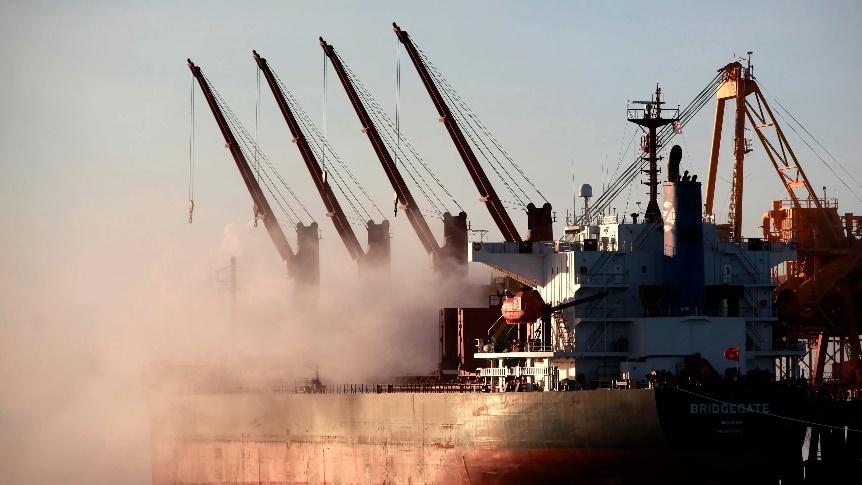
A ship at a Rio Tinto aluminum refinery in northern Australia: The mining titan is working to cut carbon emissions in its extraction and processing operations. © Reuters
SYDNEY -- Rio Tinto is digging for ways to curb greenhouse gas emissions across mining and smelting operations ranging from Australia and the U.S. to China, the company's largest market.
The mining titan will spend about $750 million to expand iron ore operations in northwestern Australia's Pilbara region. Plans announced Wednesday include a 13 km conveyor belt from the mining pits to a processing facility, which will cut greenhouse gas emissions by 3.5% compared with moving the material by truck.
The Anglo-Australian company said it is assessing "additional options to reduce emissions including renewable energy solutions." Rio Tinto exited the coal business last year as it seeks a greater focus on materials like lithium, a core component for electric vehicles.
Rio Tinto, which relies on iron ore for roughly half of its revenue, looks to reduce its carbon footprint further downstream as well.
In September, Rio Tinto announced a partnership with China Baowu Steel Group and Tsinghua University in Beijing to develop ways to reduce carbon emissions across the steel value chain.
Steel is thought responsible for 30% of all carbon dioxide emissions by the world's industries, with leading steel producer China among the countries facing the most pressure to curb its environmental impact.
China accounts for about half of Rio Tinto's group revenue, up from roughly 30% a decade ago.
"We are committed to partnering with our customers and others to find the most sustainable ways to produce, process and market" our materials, Rio Tinto CEO Jean-Sebastien Jacques said at the time.
New steelmaking processes could expand the company's client base and create licensing opportunities.
Rio Tinto also created a joint venture with Alcoa in 2018 called Elysis, aiming to eliminate all direct greenhouse gases from the aluminum smelting process. The business has received investment from Apple.
Lithium represents another opportunity, as the element is expected to see a surge in demand for use in electric-car batteries. Rio Tinto said last month that it succeeded in extracting lithium from waste rocks at a borate mine in California.
"If the trials continue to prove successful, this has the potential to become America's largest domestic producer of battery-grade lithium -- all without the need for further mining," said Bold Baatar, Rio Tinto's chief executive for energy and minerals.
The company is considering construction of a $10 million test facility over the next several months with the capacity to produce up to 5,000 tons of lithium carbonate a year -- enough to make batteries for 15,000 Tesla Model S vehicles.
October 7, 2020 News Vanessa Zhou, Australian Mining
https://www.australianmining.com.au/news/rio-tinto-to-make-beer-cans-infinitely-recyclable/
Rio Tinto has joined forces with the world’s largest brewer Anheuser-Busch InBev (AB InBev) to make beer cans out of responsibly produced, low-carbon aluminium.
This will be a first for the canned beverage industry as the two companies commit to work with supply chain partners to ensure beer cans meet sustainability standards. AB InBev will use Rio Tinto’s low-carbon aluminium made with renewable hydropower along with recycled content.
This could slash carbon emissions by more than 30 per cent per can compared with those produced using traditional manufacturing techniques. “Rio Tinto is pleased to continue to partner with customers in the value chain in an innovative way to meet their needs and help produce sustainable products,” Rio Tinto chief executive Jean-Sébastien Jacques said.
“Our partnership with AB InBev is the latest development and reflects the great work of our commercial team.” The first one million cans produced under the partnership will be piloted in the United States on Michelob Ultra, which Rio Tinto stated was the fastest growing beer brand in the country.
According to Rio Tinto, AB InBev’s packaging supply chain is the largest source of emissions by sector in the company’s value chain. Rio Tinto and AB InBev plan to integrate technology solutions into the brewer’s supply chain, advancing its transition toward more sustainable packaging and providing traceability on the aluminium used in cans.
AB InBev vice president of procurement and sustainability, North America, Ingrid De Ryck said the company was constantly looking for new ways to reduce its carbon footprint across its entire value chain.
“With this partnership, we will bring low-carbon aluminium to the forefront with our consumers and create a model for how companies can work with their suppliers to drive innovative and meaningful change for our environment,” she said.
Chantelle Benjamin 4 March 2020, S&P Global Market Intelligence
https://www.spglobal.com/marketintelligence/en/news-insights/latest-news-headlines/shareholders-unimpressed-by-rio-tinto-s-carbon-reduction-plans-file-resolution-57409769
Investors in Rio Tinto filed a shareholder resolution indicating dissatisfaction with the US$1 billion carbon reduction plans recently unveiled by the company and a lack of detail on how it plans to reach a target of net zero emissions by 2050.
Shareholders want the company to start disclosing "short, medium and long-term targets for its scope 1, 2 and 3 greenhouse gas emissions and performance against those targets," according to a March 4 filing.
The mining giant has faced other shareholder resolutions in connection with its carbon emissions, with a resolution in early February calling for targets on its customers' emissions, and one in March 2019 asking the company to report direct emissions and those of its customers in greater detail.
While Rio Tinto sold its last coal mines in 2018, the company produces iron ore used in steelmaking, which is a large contributor to carbon emissions, and investors are maintaining pressure on the company to help the sector reduce its carbon footprint.
The company released its second climate change report in late February as it announced plans to invest around US$1 billion within five years to support its objective for net-zero emissions from operations by 2050, aiming to cut its emissions intensity by 30% and its absolute emissions by 15% relative to 2018 levels.
The report received criticism for not including scope 3 emission targets, as the debate moves away from scope 1 and 2 reporting and toward indirect emissions. Competitors BHP Group and Vale SA have outlined plans to introduce scope 3 targets and Glencore PLC estimated its indirect emissions will drop 30% by 2035 as thermal coal reserves in Colombia and South Africa are depleted, Financial Times (London) reported Feb. 26.
Rio Tinto CEO Jean-Sébastien Jacques recently said the company's peers were able to make those commitments because they produce fossil fuels and can, therefore, control their scope 3 emissions, according to the Financial Times report.
On a recent media call, the CEO highlighted the company's exit from the coal sector, a joint venture focused on carbon-free aluminum smelting and a memorandum of understanding in China aiming to reduce emissions across its value chain.
"The more green aluminum and copper you produce, the better it is for the planet," Jacques said. "So for us, setting scope 3 targets and potentially shrinking the business of our customers does not make any sense whatsoever."
Rio Tinto's climate of incoherence
Robin, Myriam; Aston, Joe, The Australian Financial Review; Melbourne [Melbourne]28 Feb 2020: 40.
There goes that supreme iron ore machine Sam Walsh and Chris Lynch built at Rio Tinto, disgorging a further $US7.2 billion ($11 billion) in cash.
Only against this flush backdrop is their eccentric successor Jean-Sébastien Jacques allowed to persist with his nauseating greenwashing. While he's cutting cheques of this many zeros he could launch a space mission for exploitable minerals and institutional investors would slow clap.
"Our ambition is clear: to get to net-zero by 2050," he boldly declared on yesterday, but confessed, immédiatement, to having found no way of achieving it. "We do not have a road map but we are working on it." That's right - Rio has in mind an elegant number, and nothing else. Plainly, JS is the Bill Shorten of global resources.
"It means all of our future growth will need to be carbon neutral," Jacques added, even observing specifically that "the global task of reducing carbon emissions will require ... decarbonisation of energy generation".
But only two weeks ago, he decided to build a coal-fired electricity plant to power his copper mine in Mongolia.
After the impact of its construction, this monstrosity will besmirch the atmosphere with around 2.1 million tonnes of CO2 annually for the next 40 years. Retiring the equivalent carbon credits will replant three Amazons.
The cost of its construction - $US924 million - neutralises almost entirely Rio's $US1 billion "of climate-related spend over the next five years", also unveiled on Thursday, and utterly dwarfs the $US98 million it is outlaying for solar power and battery storage at a new Pilbara mine.
Jacques' fidelity to incoherence is worthy of its own academic study. He speaks nonsense on a grotesque scale.
"This is a massive undertaking," he says. No, it is an undertaking of no established price, scale, range, volume, capacity or extent. It is a glib fantasy.
And yet steadfastly, he declines to join BHP (and Vale) in taking "a product stewardship role for all emissions across our value chain" and to "set public goals to reduce scope 3 emissions", those caused by the refining of their iron ore into steel. Beyond starry headlines, here the hard graft lies.
This refusal perfectly captures the emptiness of Rio's noisy climate "undertakings", the difference between burnishing credentials and polishing yourself. The way Jacques bloviates, he deserves his own seat on Larry Fink's Emissions Express.
Peter Ker, Financial Review Apr 9, 2020 – 11.14am
https://www.afr.com/companies/mining/pandemic-no-excuse-to-delay-climate-action-rio-tinto-20200409-p54ii4
Governments must take "urgent" action on climate change, even as they confront the twin crises of pandemic and economic recession, says Rio Tinto chairman Simon Thompson. The coronavirus outbreak forced Rio to cancel its normal annual meeting of British shareholders on Wednesday, and replace it with a telephone conference where shareholders asked questions of Rio management.
Mr Thompson said governments must not put climate change on the backburner, even amid the global pandemic crisis. ''As the world confronts the immediate crisis of covid-19, it is vital that we do not ignore the longer term challenge of climate change,'' he said. ''If the world is to achieve the targets set out in the Paris Agreement, urgent, co-ordinated government action is essential. ''To create incentives, such as carbon pricing, for industry to invest in new low-carbon technology for these ‘hard to abate’ sectors. And to maintain the competitiveness of trade-exposed industries during the energy transition.''
Mr Thompson's call to arms on climate comes six weeks after Rio chief executive Jean-Sebastien Jacques issued an unusually frank challenge to his shareholders, telling them to clarify whether they were willing to tolerate dividend cuts in exchange for investment in emissions reduction projects. Mr Jacques' challenge came with a warning that many of the projects that Rio was considering to reduce its emissions footprint would not deliver the rates of economic return the company usually demanded before it invested capital.
Ben Butler Fri 8 May 2020 18.32 AEST, The Guardian
https://www.theguardian.com/business/2020/may/08/one-in-three-shareholders-vote-for-Rio-Tinto-to-adopt-binding-emissions-target
Shareholder vote in favour of global mining giant adopting binding targets grew sixfold since last year.
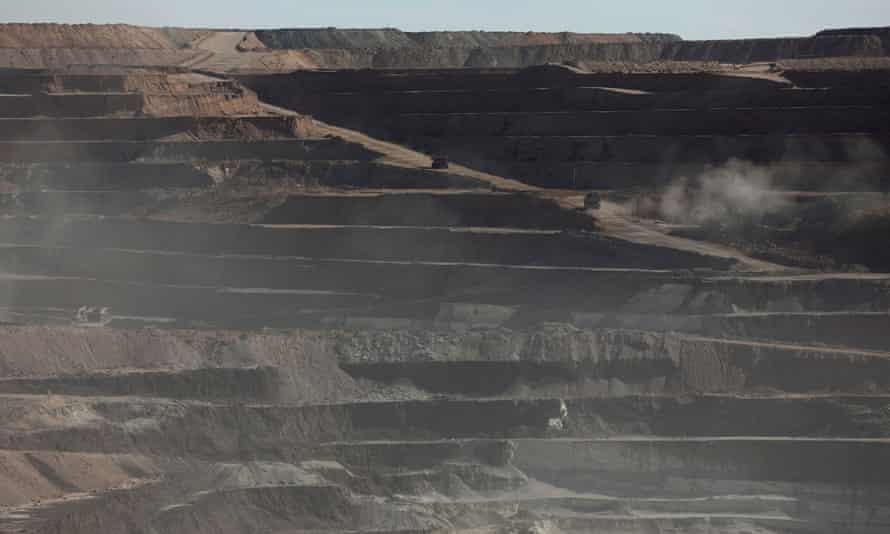
Rio Tinto is resisting shareholder pressure to set annual targets for greenhouse emissions Photograph: Patrick T Fallon/Reuters
Shareholders in global miner Rio Tinto have rebuked the company over its climate stance, with 37% voting at a meeting in Australia for a resolution that would require it to set binding emissions targets.
While the resolution did not pass, its sponsor, environmental group Market Forces, said it attracted six times as much support as an identical one put up at the same meeting last year.
The vote “shows investors have woken up to Rio Tinto’s obfuscation and the huge risks to its business from climate change and transition,” Market Forces executive director Julien Vincent said.

New Zealand threatens to sue Rio Tinto after floods threatened toxic waste
It comes after more than half of shareholders in Australia’s largest oil and gas producer, Woodside Petroleum, last week called on the company to set science-based emissions targets.
In April, almost half of shareholders in the country’s second-biggest oil and gas company, Santos, voted for a similar resolution.
Activist investors have also poured pressure on Rio Tinto’s rival, BHP, to quit the Minerals Council of Australia over the industry body’s stance on global heating – pressure the company has so far resisted.
The meeting of shareholders in the Australian-listed half of Rio Tinto followed a similar meeting by UK shareholders in April.
In its resolution, Market Forces called on Rio Tinto to set annual targets for greenhouse gas emissions and disclose its performance against those targets.
These would have included emissions classified as scope 3 – those which are produced by Rio Tinto’s customers. BHP has committed to setting scope 3 targets and linking them to executive pay.
But although Rio Tinto has said it wants to hit zero net emissions by 2050, and has struck a deal with its biggest Chinese iron ore customer to cut greenhouse gases, it has consistently refused to set scope 3 targets. “Rio’s scope 3 emissions are massive – comparable to the carbon footprint of Australia,” Vincent said. “This is a staggering level of climate risk for any company, and hence for any investor, to bear.
“With rival miners such as BHP, Vale and Glencore having already committed to set scope 3 targets, Rio has no excuse for its current policy vacuum.”
Rio Tinto chairman Simon Thompson said the majority of the company’s shareholders were “supportive of our overall approach and our position that it is not viable to set scope 3 emission reduction targets, as they relate to the emissions of our customers”.
“We will continue to engage with our investors and other stakeholders on this topic,” he said. “Rio Tinto believes the most effective climate change action will be delivered through partnerships between industry, government and society.”
Cecilia Jamasmie | May 5, 2020 | 6:18 am Intelligence Markets News https://www.mining.com/rio-tintos-top-investors-face-off-over-emissions-cut-plan/

The Weipa operation, which includes the new Amrun bauxite mine in north Queensland, Australia. (Image courtesy of Rio Tinto.)
Rio Tinto’s (ASX, LON, NYSE: RIO) top investors are set to face off at the company’s upcoming annual meeting, with only some of them in favour of pushing the miner to extend the range of its targets to reduce greenhouse gas emissions.
The world’s second-largest mining company recently committed to spend $1 billion over the next five years to reduce its carbon footprint and have “net zero” emissions by 2050.
Rio Tinto also said at the time that its total Scope 1 and Scope 2 emissions (indirect emissions from the generation of purchased energy consumed by a company, such as electricity) would be 15% lower by 2030 than 2018 levels.
Some investors want Rio Tinto to set a target to reduce so-called “scope 3” emissions — those produced when customers burn or process a company’s raw materials
The announcement triggered heated criticism from some investors and environment advocates, with a group led by a Friends of the Earth’s subsidiary tabling a shareholder motion to improve what it calls “weak” climate goals.
With three days to Rio Tinto’s annual meeting, proxy investor Institutional Shareholder Services (ISS) is recommending shareholders support the resolution that asks the miner to also tackle Scope 3 emissions — those generated by customers through the use of its products.
Shareholders “have a long-term interest in assessing whether Rio Tinto is adequately assessing and acting on its climate risk and opportunities,” including through “targets to work with its customers to achieve reductions in its scope 3 emissions,” ISS said in an April 30 note to clients.
Glass Lewis, instead, wants shareholders to reject the plan at the meeting on Thursday, Bloomberg reports.
“Not feasible”While Rio Tinto should continue to reduce its own emissions, it’s probably not “feasible for the company to set goals based on how its customers determine to utilize its products,” the adviser said in a note to clients last month.
Market Forces, a subsidiary of activist investor Friends of the Earth, has said that Rio’s current plans are a “simply a reflection of business-as-usual,” energy cost savings and efficiency measures.
“Rio Tinto is essentially telling its shareholders it is aware of a massive financial liability sitting on its books, but isn’t planning to manage that risk down,” executive director Julien Vincent said in March.
He noted that Rio’s absolute emissions would have to decline 30% in the next decade to hit the “well below” 2°C global pre-industrial levels outlined in the 2015 Paris Agreement on climate change.
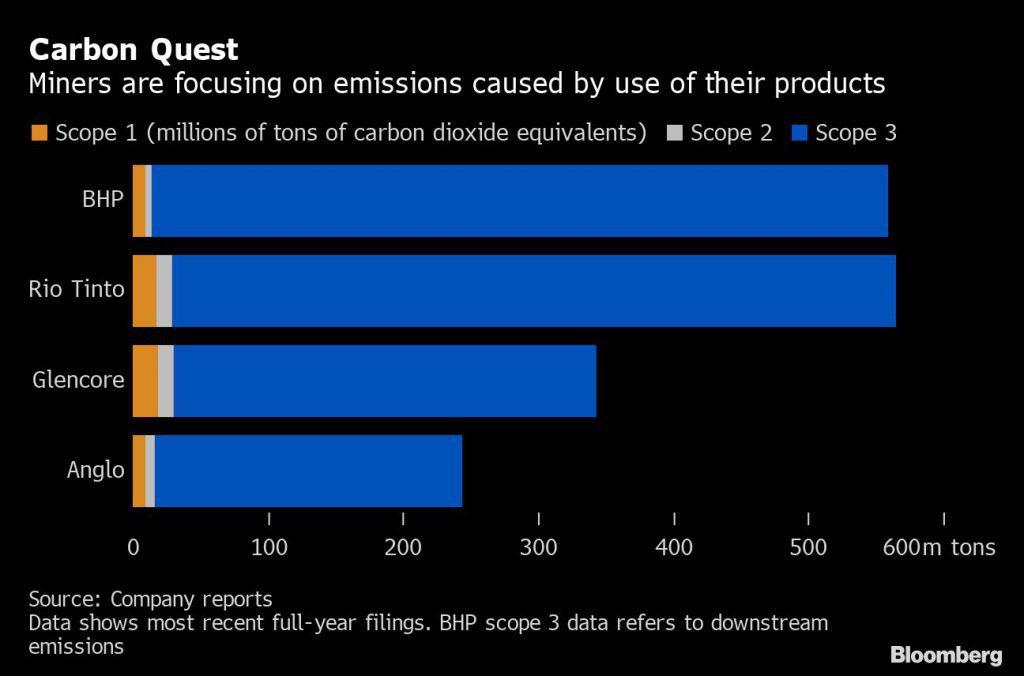
UBS analyst Glyn Lawcock said the group could almost instantly achieve the 2030 target if it sold or closed its coal-fired alumina refineries and aluminum smelters in Australia.
“We couldn’t help but notice that the closure of Pacific Aluminum alone would reduce emissions by (about) 25%,”’ he said in a note.
“Maybe this is the elegant solution to Rio’s desire to reduce carbon dioxide as well as lifting margins within the aluminum business unit,” Lawcock said.
For Julian Kettle, Wood Mackenzie’s vice chairman of metals and mining, Rio’s plans to decarbonize its globe-spanning operations are a “small but significant” step in the right direction.
“Setting Rio Tinto’s $1bn in context, this represents just 16% of the dividend it distributed in 2019, or just under 5% of its reported EBITDA of $21.2bn for the same year,” Kettle said.
The miner’s bulk of earnings come from iron ore, its main commodity and a key ingredient for steelmaking. The highly polluting industry process involves adding coking coal to make carbon steel and is responsible for up to 9% of global greenhouse emissions.
Oyu Tolgoi troublesRio’s management will also have to face criticism over its giant Oyu Tolgoi copper project in Mongolia at the annual meeting.
US hedge fund Pentwater Capital is demanding a shakeup at the mine to stop what it calls “a massive devaluation” of the asset. The investor has a 9% interest in Turquoise Hill, the Rio-controlled company that operates Oyu Tolgoi.
Rio Tinto is not the only company criticized for its current plans to cut emissions. A report released Monday by a UK-based investor initiative showed that eight of the world’s top ten largest mining companies are not doing enough to help meet international climate goals.
Posted by Mark Segal Sep 11, 2020
https://www.esgtoday.com/bhps-updated-emissions-targets-include-scope-3-actions/
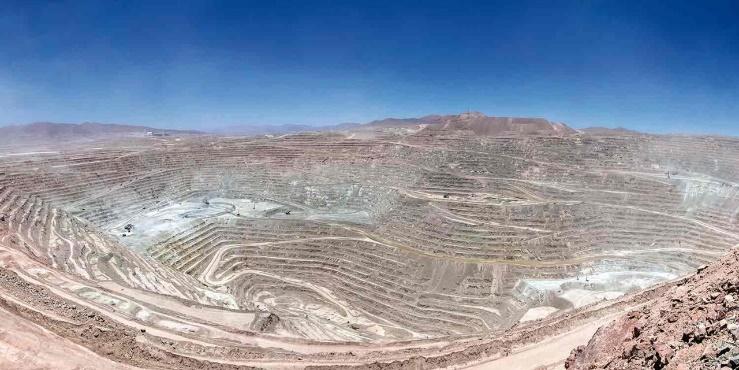
Mining, metals and energy giant BHP announced updated emissions targets as part of an update to shareholders on its climate progress and strategy. The new commitments include interim targets for GHG emission reductions, as well as plans to help decarbonise the company’s value chain (i.e., Scope 3).
BHP Chief Executive Officer, Mike Henry, said: “I’m pleased today to show how we are accelerating our own actions and helping others to do the same in addressing climate change. We see ourselves as accountable to take action. We recognise that our investors, our people and the communities and nations who host our operations or buy our products have increasing expectations of us – and are responsive to these.”
BHP’s new commitments include:
A medium-term target to reduce operational greenhouse gas emissions by at least 30% from adjusted FY2020 levels by FY2030.
Scope 3 actions to contribute to decarbonisation in BHP’s value chain. In the steelmaking market, efforts include supporting the industry to develop technologies and pathways capable of 30% emissions intensity reduction, with widespread adoption expected post-2030. In transportation, the company will support a 40% emission intensity reduction in chartered shipping of BHP products.
Strengthened linking of executive remuneration to delivery of BHP’s climate plan. Remuneration will be partially connected to reductions in operational GHG emissions, and medium and short term actions taken on the path to net zero operational emissions and Scope 3 emissions.
Insight into the performance of BHP’s portfolio in a transition to a 1.5°C scenario.
BHP stated that it supports the aim of the Paris Agreement to limit global warming to well below 2°C above pre-industrial levels, and pursue efforts to limit warming to 1.5°C. The company has already set long-term climate goals including achieving net zero operational (Scope 1 and 2) emissions by 2050, and a short-term target to maintain operational emissions at or below FY2017 levels by FY2022, using carbon offsets as required.
Henry added:
“Our approach to climate change is defined by a number of key requirements. Our actions must be of substance. They must be real, tangible actions to drive emissions down. We must focus on what we can control inside our business, and work with others to help them reduce emissions from the things that they control. To create long-term value and returns over generations, we must continue to generate value and returns within the strong portfolio we have today, while shaping our portfolio over time to benefit from the megatrends playing out in the world including decarbonisation and electrification.
“Our portfolio is well positioned to support the transition to a lower carbon world aligned with the Paris Agreement. Our commodities are essential for global economic growth and the world’s ability to transition to and thrive in a low carbon future. Climate change action makes good economic sense for BHP and enables us to create further value.”
More diamond-quality greenwashing from Rio Tinto's spin department
Aston, Joe. The Australian Financial Review; Melbourne [Melbourne]17 July 2019: 40.
Does the double dealing of self-proclaimed moral miner Rio Tinto know no bounds? And just how stupid does its publicity director Simone Niven think the market is?
An article of astonishing brazenness in The Weekend Australian on Saturday about "the closure of Rio Tinto's Argyle diamond mine next year" had the company's copper and diamonds chief Arnaud Soirat confirming it has "been approached by a number of parties interested in converting [the] mine camp into a tourist resort".
"It is a really beautiful environment, there is an airport, and there is a good camp," Soirat sounded off, more like a realtor than a digger. "There would be people who want to do something with this." Hang on, there would be people? Haven't they already approached?
Even the journalist spruiked from a glossy brochure, citing "spectacular views across the Kimberley landscape with its baobab trees and termite mounds". One man's termite mound is another's Uluru.
This is a classic Rio ploy: sell the soon-to-be-abandoned site and by so doing, void responsibility for its exorbitant rehabilitation. Hey, they just dug the hole and took the sparkly rocks away. Some other mug can fill it in and plant the flowers.
Think we're too cynical? No, we just haven't forgotten Rio's 2016 sale of its mothballed Blair Athol coal mine in central Queensland to TerraCom for $1. Rio also tipped in $80 million towards land rehabilitation, less than a quarter of its estimated total cost.
In the very same year, Rio handed back its stake in the open-cut Panguna copper mine to the Bougainville and Papua New Guinea governments, signing away its responsibility for the massive - and we mean massive - environmental degradation of the site after 45 years of majority ownership.
These are or were commercially prudent decisions, side-stepping billions of dollars in remediation and their resultant dent to total shareholder returns. But Rio cast off hard-nosed capitalism, remember?
In her heavily plagiarised speech to African mining conference Indaba in February, Niven herself declared that "in an era where we see entire industries' business models change …we need to take a good, hard look at our own".
And here's chief executive Jean-Sebastien Jacques (of Walsh Bay and Avalon, NSW) in the group's 2018 Sustainable Development Report: "We believe we can be part of the world's sustainability solution. Today, our portfolio is differentiated from our industry peers, with a fundamentally changed exposure to environmental, social and governance risks."
Which is just the most extraordinary bullshit. We preferred pitmen when they raped and pillaged the earth, and called it that. Meanwhile, costs at Rio's under-construction Oyu Tolgoi copper mine in Mongolia - the one JS personally negotiated with two prime ministers subsequently arrested (and released on bail) by anti-graft officials over their roles in approving it - continue to mount, with the latest evaluation of the blowout being $2.69 billion.
Apologies for the highfalutin' mining jargon but this project is what's known in the industry as a "rolling disaster".
Rio and its partners will spend another $1 billion constructing a power station to run the mine. And yes, it's gonna be coal-fired; that, right there, presumably their part in the world's sustainability solution?
Rio Tinto chief rejects setting greenhouse targets for customers
Anglo-Australian group sets biggest profit in 8 years but warns of coronavirus challenge
Neil Hume, Natural Resources Editor FEBRUARY 27 2020 Financial Times
Rio Tinto’s chief executive defended the miner’s decision not to set targets for reducing the carbon emissions of its customers, saying it was focused on putting its own house in order.
While the Anglo-Australian group would work with its clients, which include some of the world’s biggest steelmakers, to reduce greenhouse gas emissions, chief executive Jean-Sébastien Jacques on Wednesday said his priority was on outcomes he could control.
“We are focusing on reducing emissions at our operations . . . and we will continue to improve our environmental performance,” said Mr Jacques.
Rio on Wednesday set an “ambition” to reduce its operating emissions to net zero by 2050 and invest $1bn in climate-related projects over the next five years.
“We will not set targets for our customers. It does not make sense for us. But we are happy to work with them,” said Mr Jacques.
Last year Rio signed a pact with Baowu, China’s biggest steelmaker, and Tsinghua University, to develop new methods to reduce carbon emissions in the steel industry.
Mining companies are under pressure from investors to reduce their carbon footprint to help tackle climate change. However, the debate has shifted from the emissions created directly by mining operations to scope 3 emissions, which include the greenhouse gases generated by their customers.
Rio makes most of its money from producing iron ore, the key ingredient in steelmaking, a highly polluting industry that is reckoned to be responsible for about 7 per cent of global greenhouse gas emissions.
BHP and Vale have both promised to introduce scope 3 targets, while Glencore expects its indirect emissions to fall 30 per cent by 2035 as it allows thermal coal mines in Colombia and South Africa to deplete.
Rio argues its rivals are able to make those commitments because they produce fossil fuels and can therefore control their scope 3 emissions.
“Remember we are the only large, diversified mining and metal company that is not selling either coal . . . or drilling oil and gas,” said Mr Jacques. Rio sold its last coal mine in 2018.
Julian Kettle, vice-chairman of metals and mining at consultancy Wood Mackenzie said Rio’s new emission reduction targets were a step in the right direction but more was needed.
“A $1bn green investment, while laudable, could be funded by a 30 cents a tonne rise in the iron ore price. The industry needs to do much more,” he said.
Mr Jacques was speaking after Rio announced its biggest profit since 2011, on the back of booming iron ore prices. In the year to December, underlying earnings — the figure tracked by analysts — rose 18 per cent to $10.3bn — as the average price it received for iron ore surged 37 per cent to more than $85 a tonne.
That allowed the company to declare a final dividend of $2.31 a share, up from $1.80 a year ago.
Iron ore prices surged last year following supply disruptions and robust Chinese demand. However, there are fears prices will sink this year because of the disruption caused by coronavirus.
“The next six months could bring some challenges,” acknowledged Mr Jacques.
Rio rebuffs climate investor push
Neil Hume in London MARCH 19 2019 Financial Times
Anglo-Australian miner Rio Tinto has rejected as unworkable a proposal by climate activists to set emission reduction targets for its customers, which include some of China’s biggest steelmakers.
Rio chairman Simon Thompson said the company had “very limited control” over the carbon emissions of its clients and shareholders should therefore vote against a resolution tabled by Market Forces, a campaign group backed by Friends of the Earth, at next month’s annual general meeting.
“Firstly, the resolution calls for Rio Tinto to set targets for Scope 3 emissions. Scope 3 emissions are primarily the emissions of our customers, mainly steelmakers in China, over which we have very limited control,” Mr Thompson said in a letter to shareholders.
“Options exist for the reduction of these emissions, but the speed, economic viability and ultimate deployment of these technologies lie within the control of our customers and not Rio Tinto,” he added.
However, Mr Thompson said Rio, the world’s second-biggest producer of steel making ingredient iron ore, would provide scenarios for how so called Scope 3 emissions might be reduced. This is of increasing interest for investors worried Rio’s key iron ore business could be impacted by shifts to cleaner methods of industrial production.
In addition he said Rio, which is aiming for a “substantial decarbonisation” of its business by 2050, would set new short-term targets for tackling its direct — or Scope 1 and 2 emissions — in 2020.
Once these targets are set, Mr Thomson said Rio’s board would consider whether and how they could be linked to executive remuneration. Rio is on course to reduce direct emissions by 24 per cent between 2008 and 2020.
His comments were welcomed by Climate Action 100+— an initiative led by investors with more than $32tn of assets under management.
Helen Wildsmith of CCLA, which leads European investor engagement with Rio on behalf of the group, said she was “delighted” with the company’s plan to publish scenarios on Scope 3 emissions and pleased with the progress on other targets.
Last year, Rio’s customers released 536m tonnes of greenhouse gases, according to its recently published Climate Change Report. To put that figure in context, Rio’s Scope 1 and 2 emissions were just 28.6m tonnes.
In the report, Rio, which is the only major miner to have divested from coal, also said a push to decarbonise steel production could “materially affect the value” of its iron ore business. Last year, iron ore generated more than 70 per cent of Rio’s earnings.
In spite of Beijing’s crackdown on pollution, China’s giant steel industry continues to use blast furnaces rather than electric arc furnaces, which use recycled scrap steel and are less polluting.
Questions:
What is greenwashing?
Do you believe Rio Tinto is doing better or worse than its competitors in relation to Climate Change and Environmental Issues?
What is your perception of the penalties for the CEO and other board members which resulted from the destruction of the Juukan Gorge?
Should the Government also punish Rio Tinto for their actions on the Juukan Gorge?
Is Rio Tinto acting consistently around Climate Change and Environmental Issues?
What is the latest situation with the Resolution Copper project?
Do you believe Rio Tinto is acting in line with the clauses required by the ASX Corporate Governance Principles and Recommendations (4 ed)?
Rio Tinto CEO Jean-Sébastien Jacques claimed that “Setting scope 3 targets and potentially shrinking the business of our customers does not make any sense whatsoever”. Critically evaluate Jacques’ statement.
What are the corporate governance limitations in Rio Tinto that caused the Juukan Gorge destruction? What actions has Rio Tinto taken to address the limitations?
37



